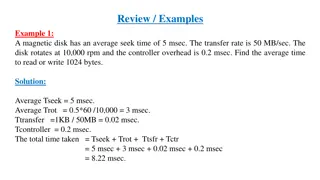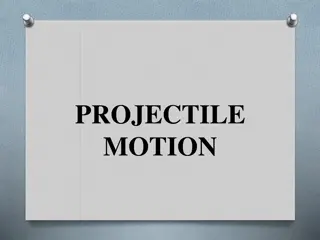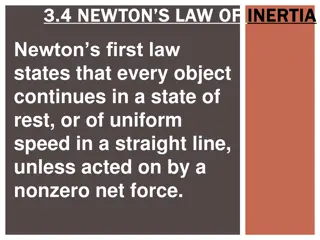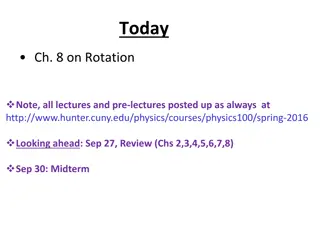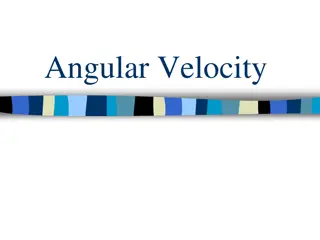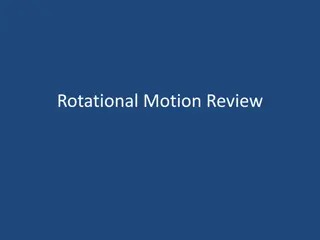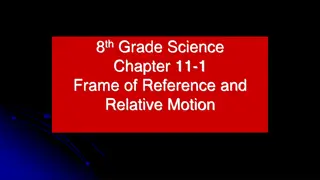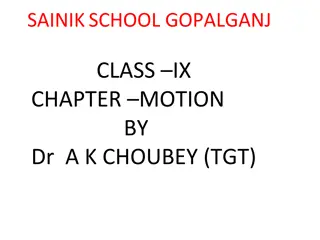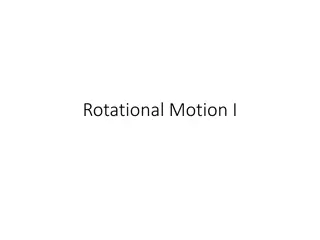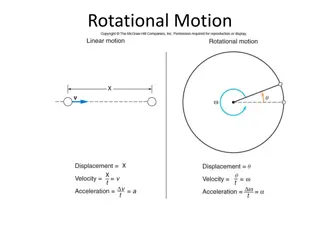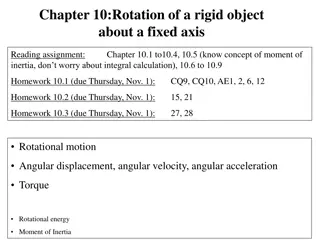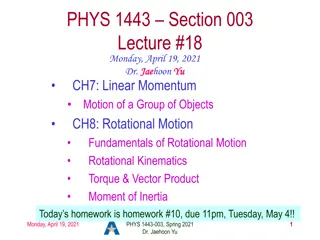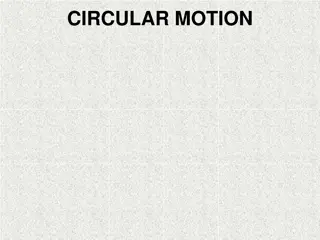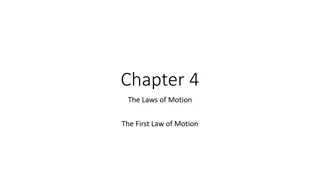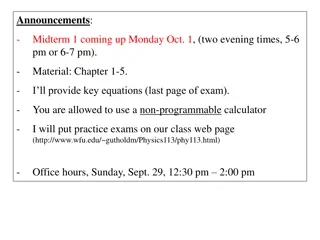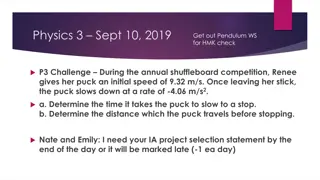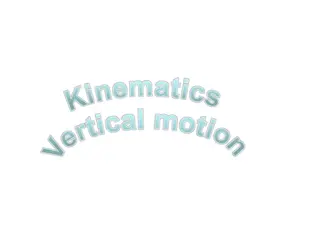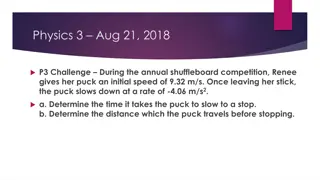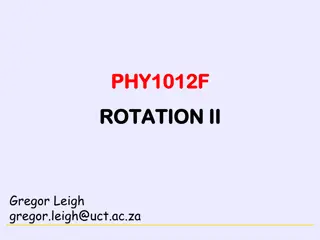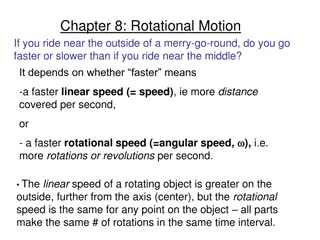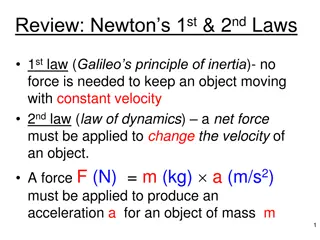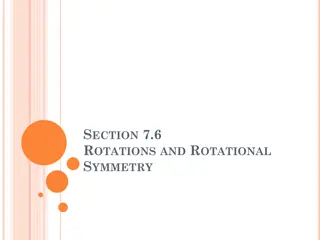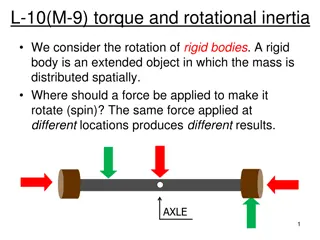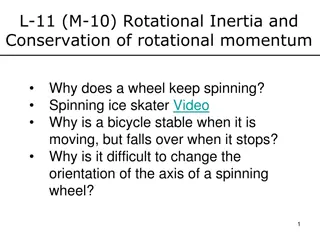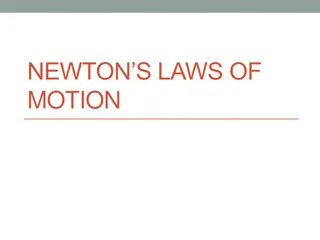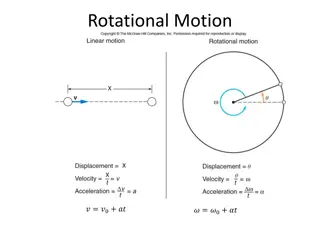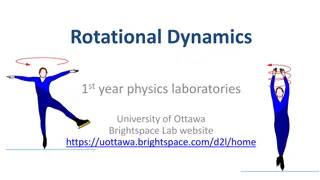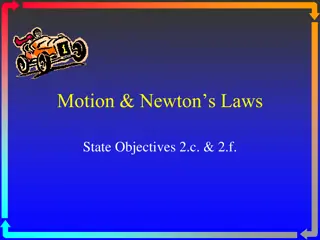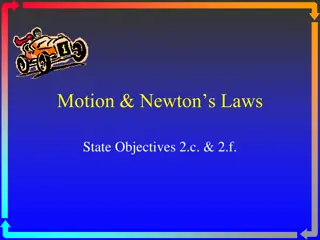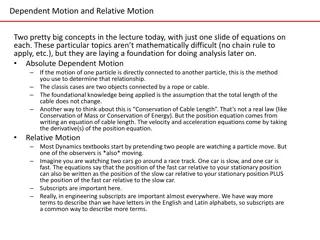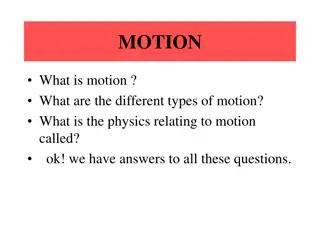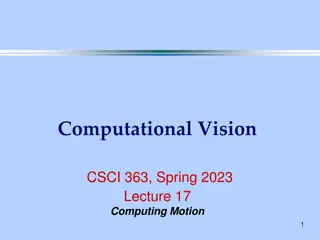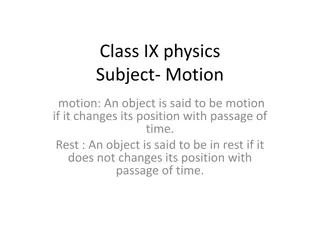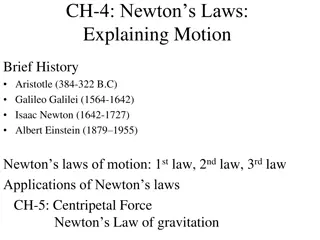Physics Presentation Slides on Rotational Motion, Thermodynamics, and Data-Based Questions
This collection features a series of presentation slides covering topics such as Rotational Motion, Thermodynamics, and Data-Based Questions in Physics. The slides provide visual explanations and discussions on concepts related to these areas, offering a comprehensive overview for learning and refer
2 views • 65 slides
Disk Performance Considerations and Calculations
Explore examples of disk performance calculations, including seek time, transfer rate, rotational speed, controller overhead, capacity calculations for platters and cylinders, and total disk capacity. Understand how to calculate average time for reading or writing data, number of platters required f
5 views • 5 slides
Projectile Motion: Characteristics, Examples, and Formulas
Projectile motion involves the motion of objects under the influence of gravity, with both vertical and horizontal components. This type of motion is seen in activities such as throwing a ball, kicking a football, or dropping objects. The motion is described by specific formulas, including calculati
2 views • 19 slides
Newton's First Law of Inertia
Newton's first law of inertia states that objects remain at rest or in uniform motion unless acted upon by an external force. This law, also known as the law of inertia, explains how objects tend to maintain their current state of motion unless influenced by an external force. Objects at rest stay a
0 views • 14 slides
Rotational Motion in Physics
Exploring rotational motion concepts in physics, including the relationship between linear and rotational speed on rotating objects like merry-go-rounds and Ferris wheels. Learn about tangential speed, angular speed, and the principle of rotational inertia that explains why objects tend to keep rota
3 views • 29 slides
Rotational Motion: Angular Velocity and Acceleration
Explore the concepts of angular velocity, radians, and rotational motion in this educational content. Learn about the relationship between angular and linear velocity, angular acceleration, tangential acceleration, and centripetal acceleration through practical examples. Enhance your understanding o
4 views • 17 slides
Rotational Motion in Physics
Explore key concepts in rotational motion through common scenarios like a point on a bicycle tire, determining centripetal forces in roller coasters, and understanding the forces at play in loops. Discover the relationship between mass, radius, and centripetal force, as well as the forces involved a
2 views • 23 slides
Motion: Frames of Reference and Relative Motion
Motion is defined as a change in position over time. To describe motion accurately, one needs to understand frames of reference and relative motion. Frames of reference are systems of objects used to determine if something is in motion, while relative motion involves movement in relation to a refere
3 views • 14 slides
Motion: Concepts and Definitions in Physics
Motion in physics is defined as the change in position of an object over time. It involves concepts like rest, motion, distance, displacement, rate of motion, and types of motion. Rest and motion are relative to a reference point, while distance and displacement differ in their scalar and vector nat
2 views • 25 slides
Rotational Motion and the Radian
Rotational motion involves rotation around a fixed axis, while the radian measures angular displacement. The relationship between translational and rotational motion is explored, defining angular velocity and differentiating between clockwise and counterclockwise rotations. Examples illustrate the c
0 views • 23 slides
Rotational Motion in Physics
Exploring rotational motion in physics involves understanding angular velocity, torque, moment of inertia, and rotational kinetic energy. This comprehensive guide covers concepts such as the conversion between degrees and radians, angular variables, Newton's second law for rotating bodies, and momen
0 views • 18 slides
Rotational Motion in Chapter 10
Exploring the concepts of rotational motion in a rigid object, focusing on angular displacement, velocity, acceleration, torque, and moment of inertia. Key topics include angular quantities, relationships between linear and angular motion, and applications in calculating rotational parameters. Pract
0 views • 29 slides
Linear and Rotational Motion in Physics
Explore the concepts of linear momentum, center of mass, rotational motion, and angular displacement in physics. Learn how to determine the center of mass of objects, analyze motion of particle groups, and understand the conservation of momentum in systems under external forces. Delve into the funda
0 views • 18 slides
Circular Motion in Physics
Circular motion involves objects moving in a circular path at a constant speed, experiencing acceleration and centripetal force. This motion is characterized by angular speed, centripetal acceleration, and the necessary centripetal force. The concept of uniform circular motion and angular displaceme
3 views • 38 slides
Newton's First Law of Motion
Exploring the foundational concepts of motion and forces, this content delves into Isaac Newton's First Law of Motion. Describing how objects behave when the net force acting on them is zero, the law highlights the significance of inertia and balanced forces in determining an object's state of rest
0 views • 9 slides
Physics Chapter 6: Circular Motion Overview
Learn about circular motion in physics, covering concepts like centripetal acceleration, uniform circular motion, and Newton's laws applied to rotational motion. Get ready for the upcoming midterm with key equations provided and practice exams available on the class web page.
0 views • 12 slides
Introduction to Rotational Motion in Physics
Explore the concepts of rotational motion in physics, including angular displacement, angular velocity, and angular acceleration. Understand how objects move in circular paths and learn about the relationships between linear and rotational variables. Dive into the study of extended bodies and the dy
0 views • 15 slides
Vertical Motion and Gravity in Kinematics
Explore the principles of vertical motion and gravity in kinematics through scenarios involving throwing objects, free-fall motion, and calculating heights. Learn how to model vertical motion with acceleration due to gravity, find maximum heights of thrown objects, solve extended problems, and under
3 views • 12 slides
Rotational Motion in Physics
Covering concepts of rotational motion including angular displacement, velocity, acceleration, and kinematics, this content explores how objects rotate and the related variables. By delving into the dynamics of rotating bodies, readers can grasp the principles underlying rotational motion.
0 views • 16 slides
Newton's Laws of Motion
Explore the fundamental concepts of Newton's Laws of Motion, including net forces, combining forces, balanced versus unbalanced forces, and the concept of inertia. Learn how these principles explain the behavior of objects in motion and at rest, and discover the impact of mass on an object's resista
0 views • 17 slides
Joint Motion: Osteokinematic and Arthrokinematic Movements
Joint motion involves osteokinematic movements, which are under voluntary control and include flexion, extension, and more. End-feel sensations like bony, capsular, and springy block indicate different joint conditions. Arthrokinematic motion refers to how joint surfaces move during osteokinematic m
1 views • 17 slides
Conservation Laws in Rotational Energy
Explore the concept of conservation laws in rotational energy, delving into the principles of mechanical energy and angular momentum conservation to solve rotational problems. Learn how to apply vector mathematics, kinetic energy formulas, and potential energy variations in frictionless systems. Mas
0 views • 18 slides
Rotational Motion: Linear vs. Angular Speed
Exploring the concept of rotational motion, this content delves into the comparison between linear speed (tangential speed) and rotational speed (angular speed). It discusses how the linear speed varies based on distance from the axis of rotation, while the rotational speed remains constant for all
0 views • 27 slides
Newton's Laws of Motion
Newton's Laws of Motion explain the relationship between forces and motion. The first law states that an object in motion stays in motion unless acted upon by a net force, while the second law describes how force is related to an object's mass and acceleration. The third law states that for every ac
0 views • 21 slides
Rotations and Rotational Symmetry in Geometry
Delve into the concepts of rotations, rotational symmetry, and the Windmill Method in geometry. Learn about different types of rotations, how to rotate points around the origin, practice rotations with given points, and understand rotational symmetry in objects. Discover the principles of rotating o
0 views • 9 slides
Torque and Rotational Inertia in Rigid Bodies
In the realm of rigid bodies, the application of force at specific points is crucial for inducing rotation. Torque, denoted by the Greek letter tau, is the product of the force and the lever arm length, determining the rotational effect. By grasping the concept of torque and its applications, one ca
0 views • 22 slides
Rotational Inertia and Conservation of Momentum
Rotational inertia symbolized as I is crucial in quantifying the torque needed for rotation, depending on mass distribution. Torque, rotational inertia, and mass influence an object's spinning motion, affecting stability and speed. Exploring why wheels keep spinning, ice skaters rotate faster when a
0 views • 23 slides
Rotational Inertia and Torque in Physics
Rotational inertia symbolizes how difficult it is to change the rotation of an object. It depends on mass distribution from the axis, shape, and mass. Torque needed to start rotation is proportional to rotational inertia. Smaller rotational inertia leads to faster rotational acceleration. Examples a
0 views • 23 slides
Newton's Laws of Motion
Newton's Laws of Motion describe how objects behave in response to external forces. The first law states that objects in motion remain in motion unless acted upon by a force, while objects at rest stay at rest. The second law relates force, mass, and acceleration, showing how they are interconnected
0 views • 11 slides
Rotational Motion and Angular Variables in Physics
Exploring rotational motion in physics, including the definition of angles in radians, conversion between degrees and radians, angular variables, torque, Newton's second law for rotating bodies, moment of inertia, rotational kinetic energy, and angular momentum. Learn about key concepts and equation
0 views • 15 slides
Rotational Kinetic Energy and Moment of Inertia
Rotational kinetic energy arises from the motion of mass in a rotating object, while moment of inertia quantifies an object's resistance to rotational motion. This concept is crucial for analyzing the energy and stability of rotating systems. The content explains the calculation of kinetic energy fo
0 views • 7 slides
Rotational Dynamics in Physics
General announcements for a physics class covering topics on rigid bodies, torque, moment of inertia, and rotational Newton's second law. Learn about the importance of moment of inertia, calculating rotational inertia, and the application of Rotational N2L in problem-solving exercises. Explore the r
0 views • 21 slides
Experimental Determination of Moment of Inertia in Rotational Dynamics Lab
In this university lab experiment, students apply known torques to various objects to measure angular accelerations and determine their moments of inertia. The setup involves rotating discs and rods with masses, using a rotational sensor for data collection. Important steps include measuring diamete
0 views • 12 slides
Motion and Newton's Laws
Explore the concepts of motion, distance, speed, and velocity as they relate to Newton's Laws of Motion. Learn about measuring motion, calculating speed, graphing motion on distance-time graphs, and understanding velocity. Discover how motion is constant and how relative motion is used. Practice cal
0 views • 36 slides
Motion and Newton's Laws
Motion is the constant change in position of objects, measured by distance and displacement. Speed is the rate of motion, while velocity includes direction. Graphing motion helps visualize speed changes over time. Newton's Laws explain the behavior of objects in motion.
0 views • 38 slides
Dependent and Relative Motion in Dynamics
Dependent Motion and Relative Motion are fundamental concepts in Dynamics, providing the foundation for future analysis. Dependent Motion involves constraints like ropes or cables, while Relative Motion considers observers in motion. Dynamics involves applying a limited set of equations in diverse w
1 views • 18 slides
Motion: Types and Physics
Motion refers to a body changing position with respect to its surroundings. Different types of motion include linear, rotatory, and oscillatory motion. The physics relating to motion is called Mechanics, which comprises Dynamics and Kinematics. Scalars and vectors play a crucial role in describing t
0 views • 8 slides
Motion Perception in Computational Vision
In computational vision, the concept of motion opponency plays a crucial role in how the brain processes left and right motion inputs. By examining psychophysical results and the construction of motion opponent energy filters, we explore how the brain handles motion information. Additionally, the Ve
0 views • 23 slides
Motion in Physics: Definitions and Examples
An object is said to be in motion if it changes position with time, while rest implies no change. Learn about types of motion such as linear and circular, as well as vibratory motion and reference points. Explore how objects can be in motion relative to one reference point while at rest relative to
0 views • 4 slides
Evolution of Motion Theories: Aristotle to Einstein
Explore the progression of motion theories from Aristotle's belief in a force for motion to Galileo's discoveries on gravity, Newton's laws of motion, and Einstein's theories of relativity and quantum mechanics. Discover how our understanding of motion has evolved over the centuries, shaping the way
0 views • 20 slides

